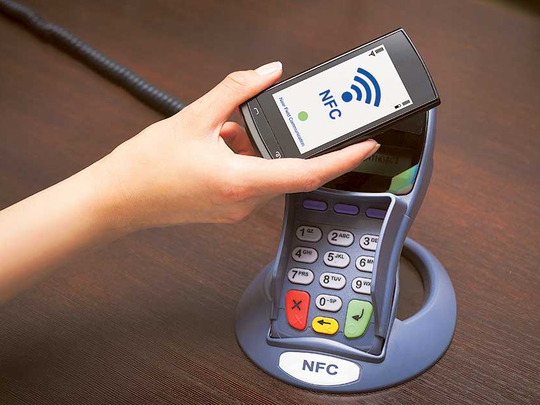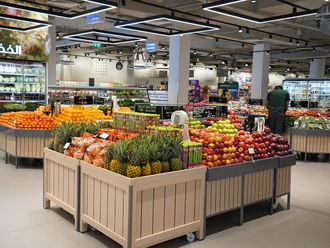
Dubai: The mobile as your wallet is finally starting to come in handy for UAE consumers. All the shopper needs to do is aim, tap or shake a smartphone at the time of transaction and the sale is sealed.
No need to carry around all that cash … and it also looks “cooler” than swiping a credit or debit card on the vendor terminal. Mobile commerce (or m-commerce, the far snappier version cropping up in conversations today) is taking the great leap forward. The Gulf’s consumers are more than willing to give it a try — a recent poll found that 77 per cent of respondents would opt for alternative payment methods if available in the region.
Those processes are finally showing up on the local digital landscape. After a relatively slow build-up, mobile-based payments are pulling in more retailers and stores into their networks and no longer confined to a few early adopters. Even more vital to ensuring the momentum does not flag, banks and financial services intermediaries are creating the type of alliances to add depth to the “cashless society”.
MasterCard has just announced a tie-in with Beam Wallet, the UAE based rewards platform, whereby the latter’s members can make a payment via a mobile at more than 3,000 stores in the UAE, including at service stations operated by Enoc. (This is done connecting MasterCard’s MasterPass digital platform with any enabled device whereby it doubles up as the wallet. Currently, nine banks in the UAE have gone live with MasterPass.) Mobility-based payments is now primed for wider acceptance. “Consumers have shifted their focus from questioning the security of mobile payments to now discussing the possibilities of enhanced digital experiences on devices,” said Raghu Malhotra, President, Middle East and Africa for MasterCard. “While a large percentage of these mobile payments are made for online shopping, food delivery and smart government services, we are seeing an increase in mobile payments at point-of-sale terminals as well, and this trend is only expected to grow with time.
“Payments using these devices is a natural and inevitable next step which you see happening in the US, UK, Singapore and elsewhere … so I wouldn’t say it’s an “if” it comes to the UAE but “when”.
“It is a fragmented marketplace and security of transactions will continue to be a top priority for MasterCard, where we remain focused on making it more convenient for customers to make more secure mobile payments while protecting them from fraud.
“We are committed to the belief that how and what we do before, during or after the payment will determine the success of our strategies in creating innovative solutions. We understand that all of our stakeholders want innovation but not at the expense of safety and security.”
For global payment transaction giants, it is just a question of rolling out platforms that have already been tried and tested in mature e-marketplaces. For m-commerce to really come up to speed, local vendors will need to call in the support of local and regional banks to create the connectivity.
Over the last two years, away from the public spotlight, these institutions have been working on the solutions.
“The contactless wave has clearly reached the Middle East with many banks in Saudi Arabia and in the UAE adopting contactless cards, such as National Commercial Bank in Saudi and RAKBank in the UAE, who we recently supported in their deployment,” said Kristel Teyras, Regional and Channel Marketing Director for Middle East and Africa at Gemalto, a solutions company. “This move paves the way for mobile payment by creating a culture of purchasing with a contactless payment device.
“To prepare for mobile payment mass adoption, banks have started to deploy contactless payment solutions using alternative factors, such as contactless payment cards and prepaid contactless wristbands for example.
“A few retailers — mainly part of large brands — have started deploying their own mobile wallet application to run loyalty programmes and enable consumers to collect vouchers and coupons, using NFC (near field communications) mobile technology. However, considering the investments involved, only large retailers can leverage on their investments.
“As soon as banks start deploying, retailers of all sizes could affiliate with banks to build on strong and compelling loyalty marketing programmes, which will make mobile wallets not only fast and convenient, but also an attractive way to pay and benefit from discounts.”
Clearly, this is where the spurt in adoption has to come from. M-commerce needs to be more than a fad or a unique selling point available at select retailers. It has to be seen as an everyday, anywhere sort of transaction for consumers to feel comfortable around it.
This is where retailers such as Enoc can help steer the usage and make mobile-based buying a utility rather than a style statement.
According to Malhotra, “Typically, a new payment method takes about 10 years to become standard after it is introduced in the market. E-commerce is a great example of this, especially in the regional context.
“Online shopping is currently in a real growth phase as we see the shift from fast followers to mass adoption. Emerging concurrently with this is the mobile trend where we see fast followers shifting their online shopping habits from web to mobile applications.”
Another sort of “wallet” in your hand
• Gulf consumers are keen enough to let their smartphones do the paying for them. Mobile wallets (with 9 per cent) was the third favoured choice for alternative payment methods after banking apps (17 per cent) and government identity cards (12 per cent). This was according to a poll conducted for the recent Cards and Payments Middle East event.
• The installed global base of contactless payment terminals at retailers will expand at an annual rate of 28.4 per cent to 74.9 million devices by the end of 2019, based on projections by Berg Insight. “This very healthy increase means 70 per cent of point-of-sales payment terminals worldwide will be NFC compatible,” said Kristel Teyras of Gemalto.












